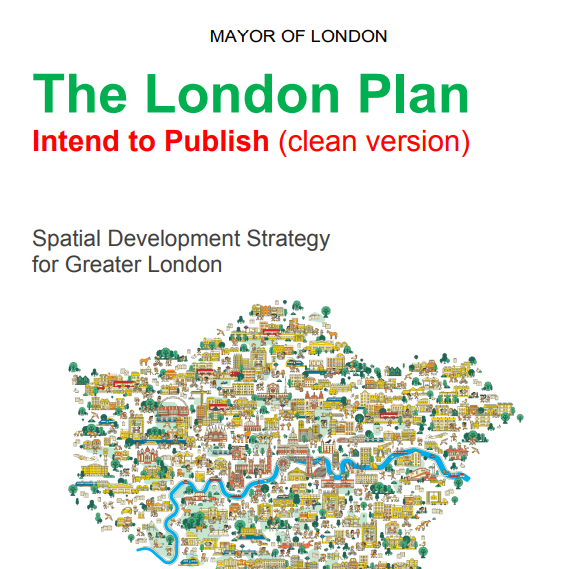The New London Plan (Intend to Publish): 8 Principles for Climate Justice
By Ellen Salter
July 2020
According to Friends of the Earth, climate justice will be achieved when inclusive progress is made 'towards equity and the protection and realisation of human rights whilst addressing the climate crisis'. But without justice, peace cannot not exist. Without peace, sustainable development cannot exist. And without sustainable development, climate-induced inequalities cannot be addressed. And so on, and so on, and so on.
At a range of geographical scales there is a clear need to embed just principles within strategic policy and to develop inclusive action plans to achieve these outcomes. One potent example is the Mayor of London’s London Plan (2016) – the pivotal spatial development strategy which sets the coherent framework for policy implementation within Greater London. In December 2019, the updated document, the draft New London Plan (Intend to Publish) (hereafter referred to as ‘The Plan’), underwent extensive consultation to account reflect wider changes since the earlier iteration.
The Plan acknowledges that London faces unprecedented challenges – climate change, air pollution, Brexit, and deeply entrenched inequality to name a few. Yet, despite this, the Mayor of London (Sadiq Khan) recognises the ‘once in a lifetime opportunity’ to set out a new way of doing things through a vision for ‘Good Growth’. Here, the Mayor of London outlines Good Growth as the ‘re-balance [of] development in London [to deliver] a more socially integrated and sustainable city, where people have more of a say, and growth brings the best out of existing places while providing new opportunities to communities.’
To ensure that London’s growth is 'Good Growth', each of the policy areas outlined within the Plan are informed by six core objectives. As declared by FoE, climate justice will be achieved when inclusive progress whilst addressing the climate crisis. As such, the following key climate justice principles within the Plan build upon the recommendations within the ‘GG1: Building strong and inclusive communities’ objective:
Promote Early and Inclusive Stakeholder Engagement: For all projects and policies engage with key stakeholders within the local community, including proportionate representation from marginalised groups (such as those from BAME, LGBTQ+, protected characteristic and other minority groups)
Create Climate Positive Development: Ensure changes to the physical and natural environment achieve an overall positive contribution to London and where appropriate, beyond the London boundary – contributions may include to carbon offsetting, the achievement of biodiversity net gain within developments, and to wider climate-positive initiatives that seek to address and benefit those who face the unequal burden of climate change impacts
Support Inclusive, Climate-Resilient Community Infrastructure: Provide access to good quality, community services, amenities and infrastructure that accommodate, encourage and strengthen communities, increasing active participation and social integration, and addressing social isolation – such facilities should promote climate-resilience, designed in line with local climatic conditions and future climate projections for at least the design life of the development
Design for Equality of Opportunity: Ensure the early adoption of measures to generate a wide range of opportunities to allow all to benefit from these to create a fairer, more inclusive, and more equal city whilst supporting the just transition towards a climate-ready future – measures include protecting the most disadvantaged from fuel poverty and supporting the provision of clean, green jobs for all
Promote a Sense of Belonging: Public spaces should be planned to account for current and projected climate conditions to protect public health. All should be invited to contribute towards the design of public spaces in the context of climate change to foster a sense of belonging and collective action against climate change
Reinforce and Enhance Identity and Inclusivity for All - Ensure that new buildings and the spaces they create are designed to reinforce or enhance the identity, legibility, permeability, and inclusivity of neighbourhoods, and are resilient and adaptable to anticipated changing community requirements in the context of climate change
Design for Accessible and Inclusive Environments - Support and promote the creation of an environment where all Londoners can move around with ease and enjoy the opportunities the city provides, avoiding separation or segregation – such as networks for active travel, climate-resilient public realm (such as shaded areas and seating), and representation within public realm of both minority figures and climate change pioneers
We’ve [all] declared a climate emergency – Following the UK's declaration of the national Climate Emergency, Sadiq Khan followed suit in London in 2019. Since then, twenty-six London Borough’s announced this declaration. All stakeholders should be invited to address the Climate Emergency in the local context. Measures are needed to recognise and reinforce needs, foster a sense of community and encourage innovation to address climate change mitigation and adaptation through diversity of thought and experience
In 2018, Sadiq Khan urged the UK government to ‘do more to avert an ecological breakdown which poses an existential threat to future generations’. But we must go beyond this. We all must do more at the individual, local and regional level to avert an ecological and societal breakdown which pose an existential threat to current and future generations. We can and we must adopt inclusive principles which place climate justice at the heart of strategic decision-making to create an equitable future for all.
© 2020 Climate Just Collective
